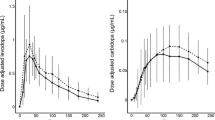Summary.
The interval of line tracing performance is more associated to basal ganglia function due to the dependence on bradykinesia and rigidity. The other component of this task, the precision of execution of complex movement sequences, is more related to attention. We compared the motor response after once dosing of 200 mg retarded release LD (levodopa)/CD (carbidopa) and of 150 mg LD/CD/EN (entacapone) by rating of motor symptoms, by measurement of LD- and 3-O-methyldopa (3-OMD) plasma concentrations and by the outcomes of a line tracing task. Thirteen treated patients with Parkinson’s disease (PD) took one of the two tested LD formulations on two consecutive days under randomised, double blind, identical standardised conditions. No significant differences appeared regarding rated motor response and LD plasma concentrations, but 3-OMD only significantly went up after LD/CD intake. LD/CD/EN was superior to LD/CD regarding the attention related components of line tracing probably due to a hypothetically increased dopamine occurrence at the prefrontal cortex, which guides human behaviour.
Similar content being viewed by others
References
AF Arnsten BM Li (2005) ArticleTitleNeurobiology of executive functions: catecholamine influences on prefrontal cortical functions Biol Psychiatry 57 1377–1384 Occurrence Handle15950011 Occurrence Handle10.1016/j.biopsych.2004.08.019 Occurrence Handle1:CAS:528:DC%2BD2MXltFSrs74%3D
G Block C Liss S Reines J Irr D Nibbelink (1997) ArticleTitleComparison of immediate-release and controlled release carbidopa/levodopa in Parkinson’s disease. A multicenter 5-year study. The CR First Study Group Eur Neurol 37 23–27 Occurrence Handle9018028 Occurrence Handle1:CAS:528:DyaK2sXhtVehsr8%3D
G Fabbrini JL Juncos MM Mouradian C Serrati TN Chase (1987) ArticleTitle3-O-methyldopa and motor fluctuations in Parkinson’s disease Neurology 37 856–859 Occurrence Handle3574690 Occurrence Handle1:STN:280:DyaL2s3gt1enuw%3D%3D
S Fahn D Oakes I Shoulson K Kieburtz A Rudolph A Lang CW Olanow C Tanner K Marek (2004) ArticleTitleLevodopa and the progression of Parkinson’s disease N Engl J Med 351 2498–2508 Occurrence Handle15590952 Occurrence Handle10.1056/NEJMoa033447 Occurrence Handle1:CAS:528:DC%2BD2cXhtVGksbnE
MJ Frank (2005) ArticleTitleDynamic dopamine modulation in the basal ganglia: a neurocomputational account of cognitive deficits in medicated and nonmedicated Parkinsonism J Cogn Neurosci 17 51–72 Occurrence Handle15701239 Occurrence Handle10.1162/0898929052880093
M Ghilardi C Ghez V Dhawan J Moeller M Mentis T Nakamura A Antonini D Eidelberg (2000) ArticleTitlePatterns of regional brain activation associated with different forms of motor learning Brain Res 871 127–145 Occurrence Handle10882792 Occurrence Handle10.1016/S0006-8993(00)02365-9 Occurrence Handle1:CAS:528:DC%2BD3cXksFGisrw%3D
CG Goetz PA LeWitt M Weidenman (2003) ArticleTitleStandardized training tools for the UPDRS activities of daily living scale: newly available teaching program Mov Disord 18 1455–1458 Occurrence Handle14673881 Occurrence Handle10.1002/mds.10591
WC Koller JT Hutton E Tolosa R Capilldeo (1999) ArticleTitleImmediate-release and controlled-release carbidopa/levodopa in PD: a 5-year randomized multicenter study. Carbidopa/Levodopa Study Group Neurology 53 1012–1019 Occurrence Handle10496260 Occurrence Handle1:CAS:528:DyaK1MXmsFersL4%3D
T Müller S Benz H Przuntek (2002) ArticleTitleTapping and peg insertion after levodopa intake in treated and de novo parkinsonian patients Can J Neurol Sci 29 73–77 Occurrence Handle11858540
T Müller C Erdmann D Bremen WE Schmidt S Muhlack D Woitalla O Goetze (2006a) ArticleTitleImpact of gastric emptying on levodopa pharmacokinetics in Parkinson disease patients Clin Neuropharmacol 29 61–67 Occurrence Handle10.1097/00002826-200603000-00001
T Müller C Erdmann S Muhlack D Bremen H Przuntek O Goetze D Woitalla (2006b) ArticleTitlePharmacokinetic behaviour of levodopa and 3-O-methyldopa after repeat administration of levodopa/carbidopa with and without entacapone in patients with Parkinson’s disease J Neural Transm 113 1441–1448 Occurrence Handle10.1007/s00702-006-0442-5 Occurrence Handle1:CAS:528:DC%2BD28XpvVaqsbs%3D
T Müller W Kuhn T Schulte H Przuntek (2003) ArticleTitleIntravenous amantadine sulphate application improves the performance of complex but not simple motor tasks in patients with Parkinson’s disease Neurosci Lett 339 25–28 Occurrence Handle12618292 Occurrence Handle10.1016/S0304-3940(02)01462-3
T Müller S Schafer W Kuhn H Przuntek (2000) ArticleTitleCorrelation between tapping and inserting of pegs in Parkinson’s disease Can J Neurol Sci 27 311–315 Occurrence Handle11097522
T Nakamura MF Ghilardi M Mentis V Dhawan M Fukuda A Hacking JR Moeller C Ghez D Eidelberg (2001) ArticleTitleFunctional networks in motor sequence learning: abnormal topographies in Parkinson’s disease Hum Brain Mapp 12 42–60 Occurrence Handle11198104 Occurrence Handle10.1002/1097-0193(200101)12:1<42::AID-HBM40>3.0.CO;2-D Occurrence Handle1:STN:280:DC%2BD3M7kslWluw%3D%3D
A Nieoullon A Coquerel (2003) ArticleTitleDopamine: a key regulator to adapt action, emotion, motivation and cognition Curr Opin Neurol 16 IssueIDSuppl 2 S3–S9 Occurrence Handle15129844 Occurrence Handle1:CAS:528:DC%2BD2cXitlylu7w%3D Occurrence Handle10.1097/00019052-200312002-00002
JG Nutt (2000) ArticleTitleEffect of COMT inhibition on the pharmacokinetics and pharmacodynamics of levodopa in parkinsonian patients Neurology 55 S33–S37 Occurrence Handle11147508 Occurrence Handle1:CAS:528:DC%2BD3MXhtFOlsw%3D%3D
P Soares-da-Silva A Parada P Serrao (2000) ArticleTitleThe O-methylated derivative of L-DOPA, 3-O-methyl-L-DOPA, fails to inhibit neuronal and non-neuronal aromatic L-amino acid decarboxylase Brain Res 863 293–297 Occurrence Handle10773222 Occurrence Handle10.1016/S0006-8993(00)02158-2 Occurrence Handle1:CAS:528:DC%2BD3cXisFGmt7o%3D
J Uekermann I Daum S Peters B Wiebel H Przuntek T Müller (2003) ArticleTitleDepressed mood and executive dysfunction in early Parkinson’s disease Acta Neurol Scand 107 341–348 Occurrence Handle12713526 Occurrence Handle10.1034/j.1600-0404.2003.02155.x Occurrence Handle1:STN:280:DC%2BD3s7psVWrtA%3D%3D
Author information
Authors and Affiliations
Rights and permissions
About this article
Cite this article
Müller, T., Ander, L., Kolf, K. et al. Comparison of 200 mg retarded release levodopa/carbidopa – with 150 mg levodopa/carbidopa/entacapone application: pharmacokinetics and efficacy in patients with Parkinson’s disease. J Neural Transm 114, 1457–1462 (2007). https://doi.org/10.1007/s00702-007-0773-x
Received:
Accepted:
Published:
Issue Date:
DOI: https://doi.org/10.1007/s00702-007-0773-x




